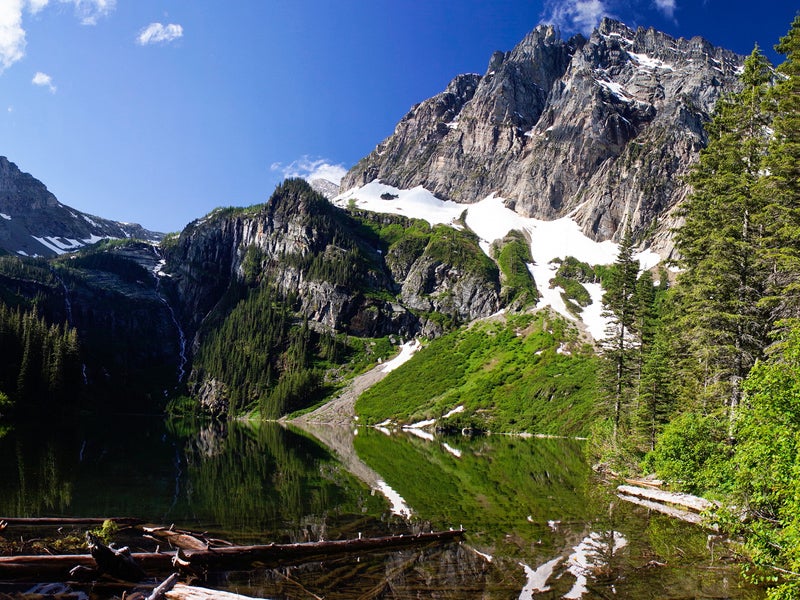Massive Mine Could Destroy One of the Last Best Places for Bull Trout and Grizzly Bears
A major mine proposal in the heart of the Cabinet Mountains Wilderness threatens to destroy one of the last remaining blocks of undeveloped habitat for bull trout and grizzly bears.

This page was published 10 years ago. Find the latest on Earthjustice’s work.
Montana—where I’m fortunate to live and work—is often called “the last best place.” The moniker is a tribute to what makes our state unique: vast expanses of undeveloped land on a scale that can be found in few places in the lower 48. This unspoiled wildness makes Montana an incredible place to explore and an invaluable area for wildlife conservation.
In the northwest corner of the state is a place that epitomizes some of the best features of our nation’s remaining wild spaces. The Cabinet Mountains Wilderness is a 35-mile expanse of glaciated peaks that supports countless species of native wildlife, including mountain goats, bighorn sheep, pikas, wolverines, moose, elk, deer, wolves, mountain lions and Canada lynx. The Cabinet Mountains also harbor populations of grizzly bears and bull trout—threatened species protected by the Endangered Species Act. These species are now under even greater threat from a proposed copper and silver mine in the core of their wilderness habitat.
As of 2014, the grizzly bear population estimate for the Cabinet Mountains was just 21 individuals, a number so precariously small that there’s a real risk grizzlies will be wiped out in the ecosystem. Indeed, federal scientists believe that a program of “augmenting” the population by importing grizzlies from other parts of the Northern Rockies is the only reason the species can still be found in the Cabinet Mountains. Nevertheless, the Cabinets offer one of the last remaining strongholds for grizzly bears in the continental United States, which is why the federal government and the state of Montana have invested substantial resources to increase the population there. Together with the neighboring Yaak River drainage, the Cabinet Mountains form one of six grizzly bear recovery areas designated by the U.S. Fish and Wildlife Service as essential to the species’ recovery.
For bull trout, too, the Cabinet Mountains hold a unique opportunity for recovery. Logging, mining and construction of dams and roads have damaged bull trout habitat in the region, but the streams originating in the wilderness still support some of the last migratory populations of bull trout, which are essential to bringing back the species.
In short, bull trout and grizzly bears in the Cabinet Mountains are already hanging on by a thread. And given widespread habitat destruction across both species’ range, restoring bull trout and grizzly bear populations in that ecosystem offers a critical opportunity to recover both species.
But the promise of the Cabinet Mountains for bull trout and grizzly bears is in jeopardy, due to a March 2014 decision by the U.S. Fish and Wildlife Service to allow a massive mining project to move forward in the heart of the wilderness. The proposed Montanore Mine project would extract up to 20,000 tons of copper and silver ore every single day for up to 20 years, transforming some of the last, best habitat for threatened bull trout and grizzly bears into a large-scale industrial mining site.
Among other harmful effects, the mine would disturb more than 1,500 acres of forest and drain water from wilderness streams—making some stream reaches go dry. The mine would also bring more than 800 people into a remote wilderness area where they are likely to encounter and kill some of the last grizzly bears surviving in the region.
The Cabinet Mountains are no place for a mine. The Fish and Wildlife Service’s own scientific evidence shows the fragile populations of grizzly bears and bull trout making a last stand in the wilderness simply can’t take it. If we mine in the heart of the Cabinets, we may well push these species beyond the point of no return.
So Earthjustice, on behalf of Save Our Cabinets, Earthworks and Defenders of Wildlife, is invoking the protections of the Endangered Species Act and taking the Fish and Wildlife Service to court in order to halt the Montanore Mine. We’ve filed suit in federal district court in Montana to overturn the Fish and Wildlife Service’s conclusion that the Montanore Mine won’t endanger the survival or recovery of grizzly bears or bull trout. If we are going to fulfill the promise of the Endangered Species Act and save the few intact ecosystems that remain in our country, we can’t let our last, best places for threatened species wind up on the rubble pile.
Established in 1993, Earthjustice's Northern Rockies Office, located in Bozeman, Mont., protects the region's irreplaceable natural resources by safeguarding sensitive wildlife species and their habitats and challenging harmful coal and industrial gas developments.